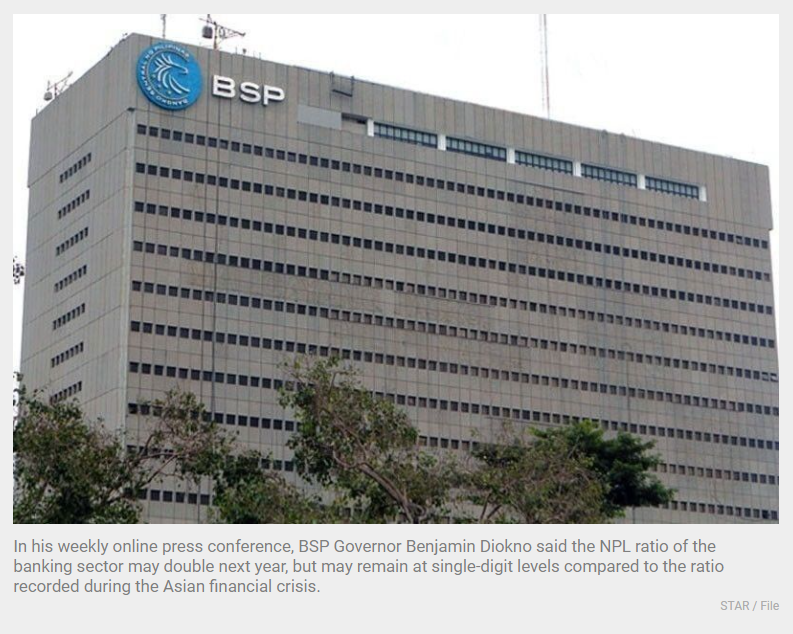Philippines: Bad loans to peak in 2022, says BSP
MANILA, Philippines — The non-performing loan (NPL) ratio of Philippine banks may peak at 8.2 percent next year, the Bangko Sentral ng Pilipinas (BSP) said.
In his weekly online press conference, BSP Governor Benjamin Diokno said the NPL ratio of the banking sector may double next year, but may remain at single-digit levels compared to the ratio recorded during the Asian financial crisis.
“We estimate that the NPL ratio is likely to peak at 8.2 percent in 2022, which is twice the current NPL ratio, but will decline in the years thereafter. This level is significantly lower than what the banking system experienced during the Asian financial crisis,” Diokno said.
Latest data from the central bank showed the gross NPL ratio of Philippine banks accelerated to a fresh 13-year high of 4.61 percent in July after easing slightly to 4.48 percent in June from 4.49 percent in May.
The latest gross NPL ratio was the highest since the 4.52 percent recorded in September 2008. The ratio was also higher than the 2.7 percent recorded in July last year.
The asset quality of the industry has been deteriorating as banks have been piling up NPLs or past due loan accounts where the principal or interest is unpaid for 30 days or more after due date as well as bad debts due to the impact of the pandemic.
Data released by the BSP showed soured loans of the banking sector jumped by 66.3 percent to P487 billion in July from P292.76 billion in the same month last year.
As banks remained risk-averse and borrower demand soft due to uncertainties brought about by the global health crisis, the loan book of Philippine banks slipped to P10.8 trillion from P10.85 trillion a year ago.
As of end-July this year, the past due loans referring to all types of loans left unsettled beyond payment declined to P573.78 billion from P576.17 billion in the same period last year, resulting in a past due ratio of 5.31 percent.
Likewise, the industry’s restructured loans amounted to P330.16 billion in July or 6.6 times the P49.75 billion booked in the same month last year, translating to a restructured loan ratio of 3.06 percent.
In anticipation of rising defaults due to the impact of the pandemic-induced recession, the banking sector’s allowance for credit losses increased by 24.7 percent to P401.5 billion from P322.07 billion. This translated to an industry’s NPL coverage ratio of 82.44 percent in end July this year from 110.01 percent in end July last year.
Diokno told reporters that BSP and the banking sector sees the NPL ratio ranging between five and six percent by December this year.
The regulator sees banks offloading P152 billion worth of bad assets via RA 11523 or the Financial Institutions Strategic Transfer (FIST) Act, helping reduce the NPL ratio of the banking sector by 0.63 to 0.71 percentage point over the next few years.
“Well a few banks have expressed interest in disposing their non-performing assets under the FIST Act,” Diokno said. The participants are just awaiting the advice from the Securities and Exchange Commission as to the list of approved FIST corporations.
The BSP chief said the Philippine banking system remains stable amid the COVID-19 crisis and in a strong position to service the financing requirements of the recovering economy.
“The positive performance of the Philippine banking system is evidenced by sustained growth in its assets, deposits, and capital, as well as ample capital and liquidity buffers and loan loss reserves,” Diokno added.
Based on end-July 2021 preliminary data, banks’ total assets grew by 5.4 percent year-on-year to P19.8 trillion. Likewise, deposits grew by 7.2 percent to P15.4 trillion, indicating the public’s continued trust and confidence in the banking system.
As of end-July 2021, total loans declined by a slower rate of 0.4 percent year-on-year to P10.8 trillion.
Diokno said credit activity is expected to improve in the coming months amid the accommodative policy stance of the BSP, the national government’s accelerated vaccination program, as well as implementation of safety measures and granular lockdowns in the National Capital Region (NCR).
Banks maintained sufficient capital and liquidity buffers, with a capital adequacy ratio (CAR) improving to 17 percent and 17.6 percent on solo and consolidated bases, respectively, in the first half of the year. These are higher than the 10 percent regulatory minimum.
Source: https://www.philstar.com/business/2021/09/23/2128986/bad-loans-peak-2022-says-bsp


 Thailand
Thailand




